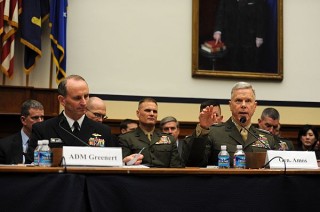
The Joint Chiefs of Staff made another round of dire warnings about impending sequestration at a hearing Wednesday, this time telling the House Armed Services Committee who may die because of budget problems — and how.
Rotary-wing pilots face particularly grave risks, according to service chiefs.
General Ray Odierno, chief of staff of the Army, pointed out that Afghanistan may well be the most challenging environment U.S. military helicopters have ever faced. While the forces in Afghanistan have top priority for funding, the new waves of troops heading to the field will be less-prepared. He said 37,000 flying hours will be cut from training, creating a shortage of 500 new pilots.
Less-prepared helicopter pilots, he said, are at a higher risk of crashing and dying, taking their passengers with them.
Soldiers may also die in greater numbers because of a lack of large-scale training exercises. Odierno said the Army is currently trained up at a squad level, rather than the battalion-level preparation it aims for. Without the practice of coordinating on a large scale, failures could lead to more deaths.
General Frank Grass, head of the National Guard, said he’s worried for his rotary pilots as well, citing their operations as a blizzard hit the northeast United States earlier this month. As training suffers, he said, National Guard pilots doing search and rescue across the country are in more danger. And if unmanned vehicles used on the Southwest border are cut, UH-60s will have to fly more missions, deteriorating even more quickly, even as the Guard defers sustainment and maintenance requirements for aircraft.
The National Guard also will delay and cancel training events for 13,000 soldiers responsible for responding to chemical and biological terrorism attacks and domestic industrial accidents.
Fixed-wing pilots are on the firing line as well. According to Chief of Naval Operations Admiral Jonathan Greenert, Central Command would end up short one carrier aircraft wing. Then the Navy could not support both Afghanistan operations and any emergency in the Persian Gulf. Ships also will be unavailable for counterterrorism in Africa and drug-smuggling interdiction off the coast of Latin America.
The Air Force will lose F-35 readiness, said General Mark Welsh, Air Force chief of staff. As two-thirds of its combat units curtail training, he added, “Most, if not all, will be completely non-mission-capable by July.”
And Marine Corps Commandant General James Amos said the service’s nine squadrons will have fewer than half the aircraft they need ready to operate by the end of fiscal 2013. The next two squadrons on their way to Afghanistan will be at full strength, he said, but that just rolls the shortage on squadrons down the line.
“The squadrons that are back home preparing to go will have less than five of a twelve-plane squadron,” he said.
Amos gave a rundown of the non-Americans whose lives depended in the past three years on operations the Marines wouldn’t have money to carry out under sequestration and the continuing resolution. He counted hundreds of thousands of civilians rescued from floods in Pakistan, a typhoon in the Philippines and the tsunami that struck Japan.
Welsh stressed that the armed forces will have no a choice but to respond the next time they are called, regardless of shortfalls.
“When the next major conflict starts we will send our combat force to fight,” Welsh said. “And they will go, and they will die. In higher numbers than they have to.”




